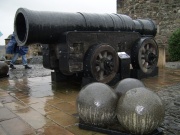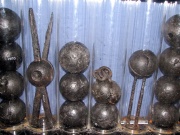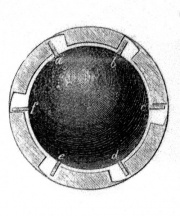Round shot

Round shot (or solid shot, or a cannonball, or simply ball) is an obsolete solid projectile without explosive charge, fired from a cannon. As the name implies, round shot is spherical; its diameter is slightly less than the bore of the gun it is fired from.
Round shot was made in early times from dressed stone, but by the 17th century, from iron. It was used as the most accurate projectile that could be fired by a smooth-bore cannon, used to batter the wooden hulls of opposing ships, fortifications, or fixed emplacements, and as a long-range anti-personnel weapon.
Along with pellet shot and grapeshot, round shot was one of the early projectiles used in firearms.
Round shot was used by naval guns during most of the age of sail, being replaced after the invention by Benjamin Robins of the extruded bullet around the mid-19th century.
In land battles, round shot would often plough through many ranks of troops, causing multiple casualties. It could bounce when it hit the ground, striking men at each bounce.
Round shot has the disadvantages of not being tightly fitted into the bore (to do so would cause jamming). This causes the shot to "rattle" down the gun barrel and leave the barrel at an angle unless wadding or a discarding sabot is used.
Round shot has been totally replaced by modern bullets in small arms and by modern shells in artillery. Round shot is used in historical recreations and historical replica weapons.
Pellet shot (now simply called 'shot') is still used in shotguns.
In the 1860s, some round shots were equipped with winglets in order to benefit from the rifling of cannons. Such round shot would benefit from gyroscopic stability, thereby improving their trajectory, until the advent of the ogival shell.[1]
Notes
- ↑ Musée de la Marine, Paris
See also
External links
- Photo of stone round shot from the Castello Sforzesco in Milan, Italy

This article or section is just a stub, and could use more information to fill in the missing bits.
You (yes, you!) can help Gunsopedia and our users by using your own knowledge to expand it

